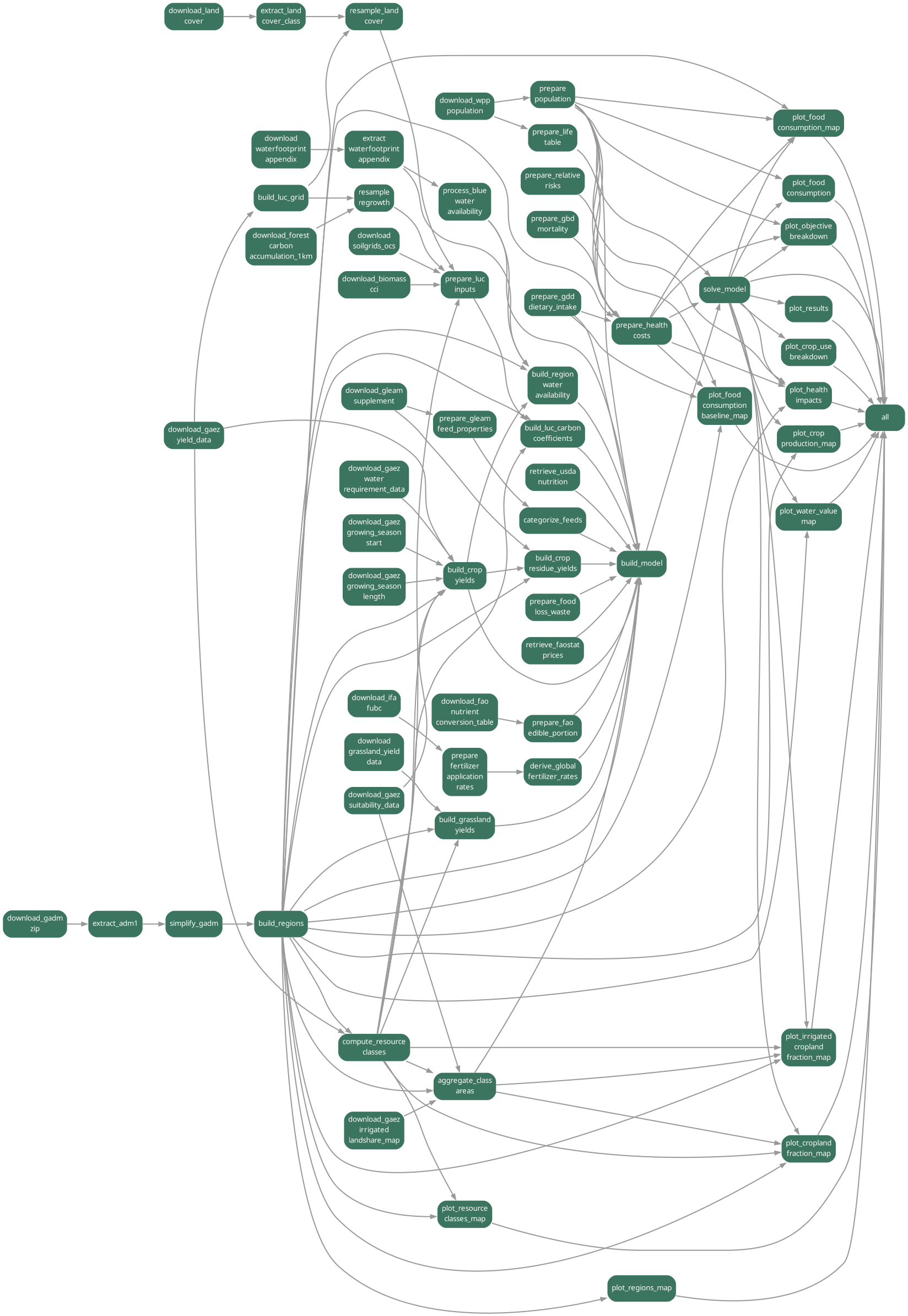Workflow & Execution¶
Overview¶
The food-opt model uses Snakemake for workflow orchestration. If you have never used Snakemake before, consider having a look at the official tutotial to get familiar with the basic concepts. The workflow follows these main stages:
Downloads (GAEZ, GADM, UN WPP, FAOSTAT)
Preprocessing (regions, resource classes, yields, population, health)
Model Building (PyPSA network construction)
Solving (LP optimization with health costs)
Visualization (plots, maps, CSV exports)
Each stage is defined by Snakemake rules that specify inputs, outputs, and a script or piece of code.
The complete workflow dependency graph is shown below. Each node represents a Snakemake rule, and edges show dependencies between rules.

Complete workflow dependency graph showing all Snakemake rules and their relationships¶
Key Snakemake Rules¶
Data Preparation Rules¶
- simplify_gadm
Input:
data/downloads/gadm.gpkgOutput:
processing/shared/gadm-simplified.gpkgScript:
workflow/scripts/simplify_gadm.pyPurpose: Simplify administrative boundaries for faster processing
- build_regions
Input: Simplified GADM
Output:
processing/{name}/regions.geojsonScript:
workflow/scripts/build_regions.pyPurpose: Cluster administrative units into optimization regions
- prepare_population
Input:
data/downloads/WPP_population.csv.gzOutput:
processing/{name}/population.csv,processing/{name}/population_age.csvScript:
workflow/scripts/prepare_population.pyPurpose: Extract population for planning horizon and countries
- compute_resource_classes
Input: All GAEZ yield rasters, regions
Output:
processing/{name}/resource_classes.ncScript:
workflow/scripts/compute_resource_classes.pyPurpose: Define yield quantile classes within each region
- aggregate_class_areas
Input: Resource classes, suitability rasters, regions
Output:
processing/{name}/land_area_by_class.csvScript:
workflow/scripts/aggregate_class_areas.pyPurpose: Compute available land area per (region, class, water, crop)
- build_crop_yields
Wildcards:
{crop}(crop name),{water_supply}(“r” or “i”)Input: Resource classes, GAEZ rasters (yield, suitability, water, growing season)
Output:
processing/{name}/crop_yields/{crop}_{water_supply}.csvScript:
workflow/scripts/build_crop_yields.pyPurpose: Aggregate yields by (region, class) for each crop
- build_grassland_yields
Input: ISIMIP grassland yield NetCDF, resource classes, regions
Output:
processing/{name}/grassland_yields.csvScript:
workflow/scripts/build_grassland_yields.pyPurpose: Aggregate grassland yields for grazing production
- prepare_health_costs
Input: Regions, DIA health data, population
Output:
processing/{name}/health/*.csv(risk breakpoints, dose-response, clusters)Script:
workflow/scripts/prepare_health_costs.pyPurpose: Compute health cluster parameters for DALY calculations
Model Building and Solving¶
- build_model
Input: All crop yields, grassland yields, land areas, population, water availability, static data files (crops.csv, foods.csv with pathway-based processing, etc.)
Output:
results/{name}/build/model.ncScript:
workflow/scripts/build_model.pyPurpose: Construct PyPSA network with all components, links, and constraints. Creates multi-output links for crop→food conversion based on processing pathways defined in foods.csv.
- solve_model
Input: Built model, health data, food-to-risk mapping
Output:
results/{name}/solved/model.ncScript:
workflow/scripts/solve_model.pyPurpose: Add health costs, solve LP, save results
Visualization Rules¶
- Plots and maps (see
workflow/rules/plotting.smk): plot_regions_map: Optimization region boundariesplot_resource_classes_map: Resource class spatial distributionplot_crop_production_map: Crop production by regionplot_crop_land_use_map: Land use by cropplot_cropland_fraction_map: Cropland fraction of each regionplot_water_value_map: Water shadow prices (economic value)plot_health_impacts: Health risk and baseline mapsplot_results: Production, resource usage, objective breakdownplot_food_consumption: Dietary compositionplot_crop_use_breakdown: How crops are used (food vs. feed vs. waste)
Execution Commands¶
Running the Full Workflow¶
Build, solve, and visualize everything:
tools/smk -j4 --configfile config/my_scenario.yaml all
-j4: Use 4 parallel cores (adjust to your CPU count)--configfile config/my_scenario.yaml: Specify which configuration file to useall: Target rule that depends on all major outputs (strictly speaking optional)
This will:
Download datasets (if not already cached)
Process data for configured scenario
Build and solve the model
Generate all plots and exports
Running Specific Stages¶
Build model only (no solving):
tools/smk -j4 --configfile config/my_scenario.yaml results/my_scenario/build/model.nc
Solve model:
tools/smk -j4 --configfile config/my_scenario.yaml results/my_scenario/solved/model.nc
Regenerate specific plot:
tools/smk --configfile config/my_scenario.yaml results/my_scenario/plots/crop_production.pdf
Prepare data without building model:
tools/smk -j4 --configfile config/my_scenario.yaml processing/my_scenario/regions.geojson processing/my_scenario/resource_classes.nc
For any of the above targets, Snakemake will first run any other previous rules in order to generate the necessary inputs for the specified target output/rule.
Checking Workflow Status¶
Dry-run (show what would be executed without running):
tools/smk --configfile config/my_scenario.yaml -n
Dependency graph: See the workflow dependency graph figure at the top of this page. To generate a detailed job-level DAG for a specific configuration (requires Graphviz):
tools/smk --dag all | dot -Tpdf > dag.pdf
List all rules:
tools/smk --list
Memory Management¶
The tools/smk Wrapper¶
It is possible to run the workflow directly with the snakemake command. Food-opt, however, provides a simple shell script, tools/smk, which:
Runs Snakemake in a systemd cgroup with hard memory limit (default 10 GB), killing the process group if memory limit is exceeded
Disables swap to prevent system instability
Sets the
-j1argument (running only one job at a time) by default unless the user sets the-j<n>option explicitly.
Default memory limit: 10 GB (configurable via SMK_MEM_MAX environment variable)
Override memory limit:
SMK_MEM_MAX=12G tools/smk -j4 all
Parallelization¶
Snakemake automatically runs rules concurrently (e.g., downloading multiple GAEZ files, processing yields for different crops), depending on the configured number of parallel rules allowed. This is set with the -j<n> option, where n is the number of parallel rules. Note that individual rules (such as the model solving rule) may use more than one processor core.
Snakemake automatically detects dependencies and runs tasks in correct order.
Incremental Development¶
Workflow philosophy: Snakemake tracks file modification times and only reruns rules whose inputs changed. This includes rule input files, the script associated with the rule as well as rule parameters (relevant configuration sections).
Example workflow:
Run full workflow:
tools/smk -j4 allModify crop list in config → only crop yield rules rerun
Modify solver options → only
solve_modelreruns (build model reused)Modify visualization script → only plotting rules rerun
Rerun specific rule:
tools/smk -j4 --configfile config/my_scenario.yaml results/my_scenario/solved/model.nc --forcerun solve_model
Mark all existing outputs as up to date (preventing rules from being run due to modification times, etc.):
tools/smk --configfile config/my_scenario.yaml --touch